
views
Getting Started
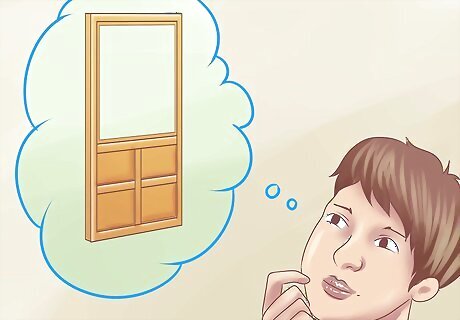
Decide what type of storm door you want to install. The first step in installing a storm door is deciding what kind of storm door you want. This comes down to your personal preferences and functionality requirements. Do you want the storm door for additional security? For ventilation or energy efficiency? Or do you simply want to create a certain look? You can purchase storm doors made from metal, wood or vinyl/plastic, depending on the look you're trying to achieve. Decide whether you want a full view, ventilating or rollscreen storm door. Full view has a single pane of glass or a screen, ventilating has two glass panels which slide up or down to expose a screen, and rollscreen has a roll-up screen on a tensioned dowel which gives you the benefit of both full view and ventilating. You will also need to consider your budget. Standard-sized storm doors can cost anywhere from $100-$300 (vinyl or plastic doors tend to be cheaper than hardwood or metal) while custom doors can cost as much as $500.
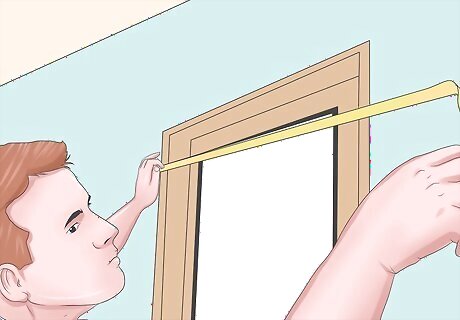
Get measurements for your storm door. Before you purchase a storm door, you will need to measure the height and width of your current door opening. This will allow you to choose the right sized storm door from a range of standard sizes, or if your door opening has unusually tall or wide openings, you can use your measurements to order a custom storm door. To get your measurements, measure the width of the door opening from inside trim to inside trim, and measure the height of the door opening from the threshold to the underside of the header. Do this in three separate spots for both the width and height and take note of the smallest measurement for each, as this is the one you will be using. For more detailed instructions on how to measure for a storm door, see this article.

Gather your tools and materials. Once you have purchased an appropriate storm door and are ready to install, it's time to gather your tools and materials. You will need: Materials: Storm door unit, #8 x 1" screws. Tools: Power drill, hammer, hacksaw, level, screwdriver, sawhorses, spirit level, measuring tape. Open up the box containing the storm door unit and find the instruction manual. Cross-reference the list of parts on the instructions with the contents of the box to ensure nothing is missing. As storm door installation varies slightly depending on make and model, check the instructions to see if any additional tools or materials are required.
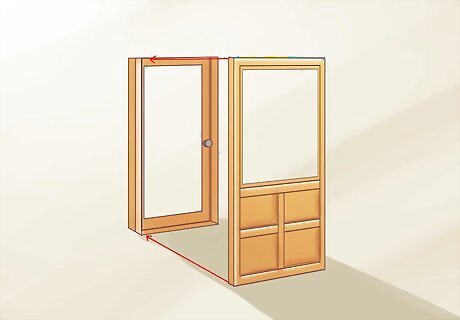
Determine the hinge side of the storm door. Before you begin, you will need to determine which side of the storm door is the hinge side. Most storm doors will hinge on the same side as the entry door, however in some cases, you will need to hinge the door on the opposite side. This may be necessary if there is an obstruction which would prevent the storm door from swinging open on one side, such as a mailbox or porch pillar. Use a piece of duct tape to mark the hinge side of the storm door. This will save you some confusion later on.
Installing the Door
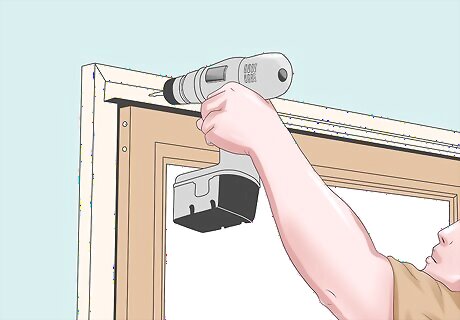
Install the drip cap. The drip cap (also known as a rain cap) is the top part of the storm door frame. One side is lined with fuzzy fabric strip which prevents water from leaking in behind the storm door. Center the drip cap along the top of the door opening, pressing it tightly against the brick mold. Use a pencil to mark where the screws will go, then set the drip cap down and use your power drill to pre-drill the holes. Reposition the drip cap, then insert a single screw on the hinge side of the door. Leave the other holes un-screwed for now -- you can secure the drip cap fully once the storm door is installed. Note: The manufacturers of some storm door models only recommend installing the drip cap after the storm door is in place. If this is the case, you should hold off on installing the drip cap for now -- always follow the manufacturer's instructions.
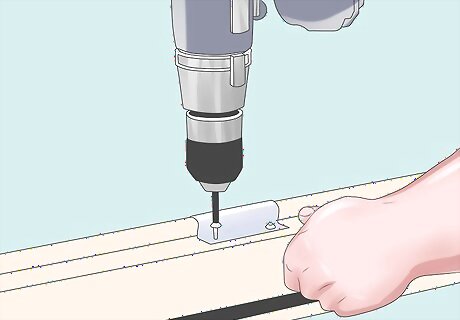
Attach the hinge-side z-bar to the door frame. The hinge-side z-bar is an aluminum component which attaches to the hinge-side of the storm door. To attach it, lay the door frame on its side, with the hinge-side facing up. Take the hinge-side z-bar and line it up along the side of the door. Allow ⁄8 inch (0.3 cm) of the z-bar to extend above the top of the door -- this ensures that the top of the door clears the drip cap upon closing. Use your drill to screw the hinges of the z-bar into the frame of the storm door.
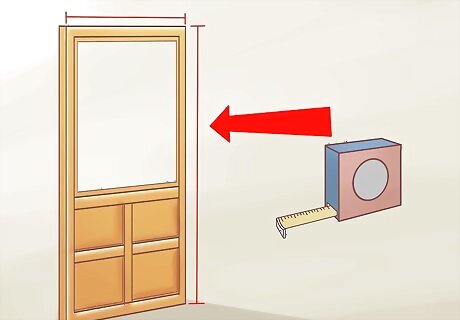
Cut the hinge-side z-bar to length. Once attached, the hinge-side z-bar will usually extend beyond the bottom of the door frame. This excess will need to be removed to ensure that the door frame fits into the opening. Take your measuring tape and measure the height of the door opening from the threshold to the bottom of the drip cap. Use this measurement to mark the appropriate point on the hinge-side z-bar with a pencil, then use your hacksaw to cut the bar to length.
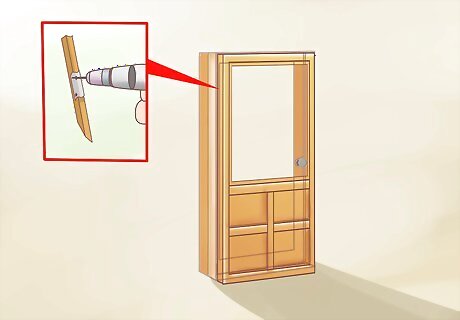
Fit the storm door to the opening. Pick up the storm door and set in into the door opening, making sure that the top of the hinge-side z-bar is flush with the drip cap. If you like, you can use a spirit level to make sure the door is plumb. Use your drill to secure the top-most hinge with a screw. Ensure that the door is sitting squarely in the opening, then open and close it a couple of times to make sure it swings freely. Once you are happy with the door's position, secure the remaining hinges using the drill and screws.
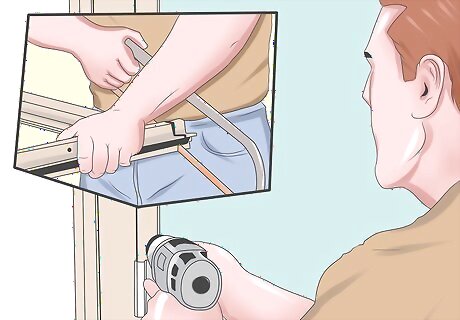
Measure and cut the latch-side z-bar. Take the latch-side z-bar and hold it up against the latch-side brick mold. If the fuzzy-looking weather stripping is facing the exterior, the z-bar is right-side up. If it's facing the interior, the z-bar is upside down and you will need to flip it around. Use a piece of duct tape to mark the top end of the bar. Set the z-bar aside for a moment and use your tape to measure the length of the door opening from the threshold to the underside of the drip cap. Use this measurement to mark and cut the bottom of the z-bar to size using a hacksaw.
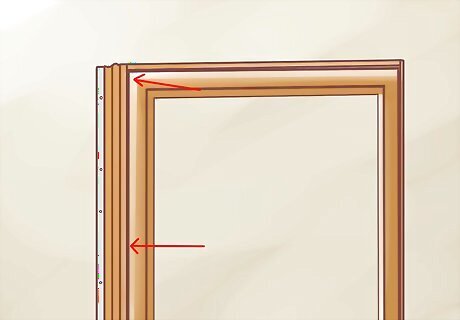
Attach the latch-side z-bar. Press the latch-side z-bar against the latch-side of the door opening, making sure the top of the bar is pushed against the underside of the drip cap. Close the storm door and use your measuring tape to ensure that you have a consistent 3/16" gap between the latch-side z-bar and the storm door. Keeping the door closed, drill a pilot hole in the top of the latch-side z-bar and secure with a screw. Repeat at the bottom and in the middle of the z-bar. At this point you can also finish securing the drip cap.
Finishing the Job
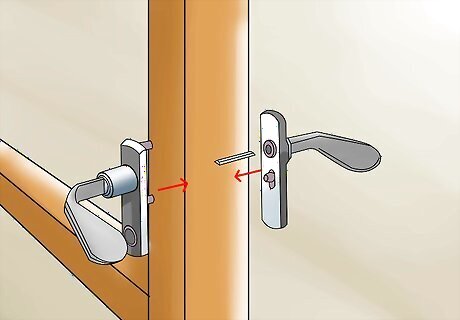
Attach the handle set. How you attach the handle to your storm door will vary according to the type of handle provided by the manufacturer. As a result, you will need to refer to the manufacturer's guide for specific instructions on how to install it. On a more general note, make sure that the handle of the storm door will not hit against the handle of the entry door when the door is closed. If it does, you will need to reposition the handle.
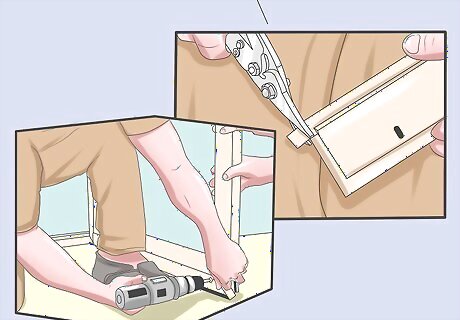
Install the expander sweep. The expander sweep is used to close up the gap between the threshold and the bottom of the storm door. If it's not already attached, slide the black strip of rubber (weather stripping) onto the track, then cut off any excess. Use your pliers to pinch the ends into place. Slide the expander sweep onto the bottom of the storm door, then get inside and close the door behind you. Adjust the sweep until it closes as much of the gap beneath the door as possible --this will provide a tighter seal, keeping rainwater out. Pre-drill two holes, then secure the expander sweep with a screw on either side.
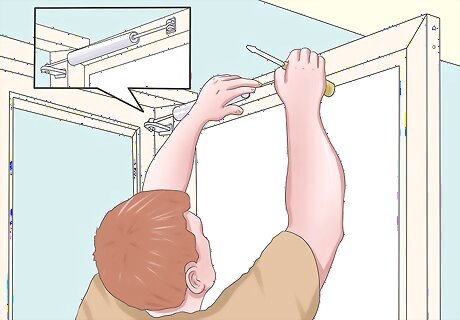
Install the closing mechanism. Attach the closer mechanism to the inside of the storm door, following the manufacturer's instructions. Some storm door kits will provide two closer mechanisms -- one for the bottom and one for the top of the door. To adjust the speed of the closing mechanism, you can loosen or tighten a specific screw at the top of the closers. Test the speed by opening the door and allowing it to close on its own.
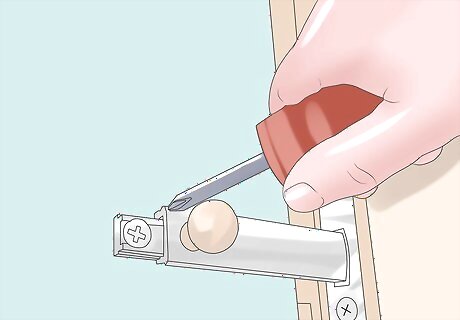
Attach the striker plate. The last step is to install the striker plate. A good tip for getting the alignment just right is to open the storm door and twist the lock. Now carefully close the door until the protruding lock hits the frame. Use a pencil to mark the points where the top and bottom of the lock hit the frame. Open the door, and use your pencil to extend these pencil marks into straight, horizontal lines which wrap around the frame. Take your striker plate and use these pencil lines to position it correctly. Secure the striker plate in place with a number of screws, then close the storm door. Make any necessary adjustments.




















Comments
0 comment